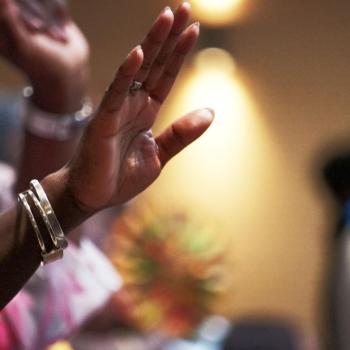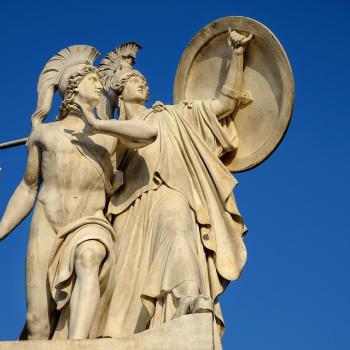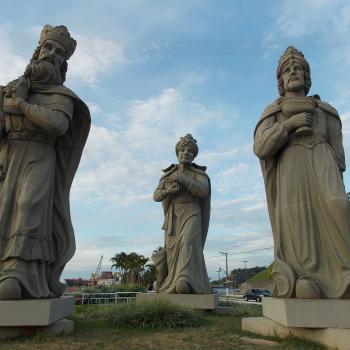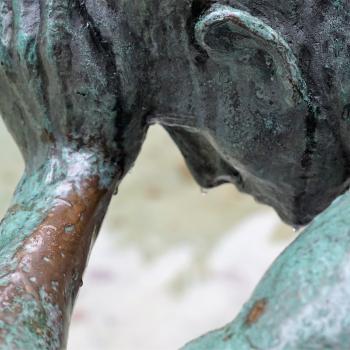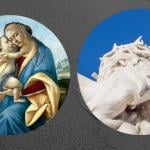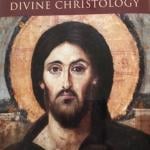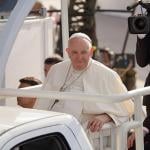If you’ve stuck with this exploration thus far, you’re doing well. I know we’re wrestling with some complicated issues. I wish I were writing a Harry Potter novel instead. (Steven wishes it oh so much more fervently. I can’t even tell you.) But this is what I’m given, and so this is what I can give. No movie version forthcoming.
Anatolios begins the next section of his book by recognizing the apparent problem of continuity and development. That is, if the Creed is shaped by the language of 4th– and 5th-century Greek and Latin conversations, exactly what does it have in common with biblical images and terms from the 1st century? Are we experiencing something new? And if so, how can we understand it as a legitimate extension of the gospel rather than an innovation?
This is a Dan Brown problem. Dan Brown of Da Vinci Code fame. Danny likes to make us think that whatever was going on in the gospel and the decades immediately after was pretty much abandoned by the 4th century in favor of something much more exciting and, frankly, much more conducive to imperial power. It served the purposes of the Empire well to have a Jesus who was divine, so by all means let’s deify the Jewish prophet. Let’s make this long-dead Jesus a god.
No one who studies the writings of those centuries can really argue that with much credibility. In fact, scholars point out that one of the biggest arguments of those years was not whether or not Jesus was divine, but whether or not he was really human! Many of them had to fight hard to keep Jesus a real human being rather than making him into a God with a human “cloak” thrown around him.
In his explanation of what was going on in these early centuries, Anatolios uses the ideas of a French philosopher, Gabriel Marcel. Marcel wrote about the difference between “primary reflection” and “secondary reflection.” Not to get all philosophyish on you, but this is a really helpful distinction, one that we actually all experience frequently.
Marcel explains primary reflection like a stream of thought, gushing along in predictable tracks, and then encountering some break in the current, some obstacle plunked down in the middle of the stream. An event, a discovery, a new thought, a problem. And then what happens? Marcel calls this a “break” in the flow of experience, and uses two examples: one, something quite small, like losing your watch; the other, much deeper, like lying to a friend. Both of these create the awareness of an anomaly that must be confronted.
If I lose my watch, I have to stop and retrace my steps… a small matter. But as I do so, I may become aware that I’m often careless and forgetful. If I “catch” myself lying to my friend, it may push me to recognize that I am trying to hide something about my character, or that I give myself certain privileges, like white lies, that I judge others about quite harshly. Hmm. Hopefully, I learn something about myself, and I adjust the flow of my awareness to accommodate that new experience and make necessary changes.
This process of recognition is secondary reflection. It proceeds in continuity with the old course, but at a new level. I understand something new about myself, even though it has really always been a part of me; and that new understanding now becomes a part of the way I understand myself and my world – it affects my future choices and behavior and relationships with others.
Here is Marcel’s summary: “Roughly, we can say that where primary reflection tends to dissolve the unity of experience which is first put before it, the function of secondary reflection is essentially recuperative; it reconquers that unity.”
Here is Mulhern’s summary: “We used to be comfortable with who and what we were, but some experience has interrupted that and is making us see things we hadn’t seen before; so we work them through in ways that help us integrate them and move forward.”
So back to the early church. It’s cooking along, surviving and even thriving amidst the persecution and challenges of pluralism, and then suddenly something bubbles up to the surface, and the church says, “What? What’s this? And what do we do with it?” (Arius, our poster-child heretic, was one of the earliest to ask those questions, so he got to be Answer A. A for Arius, but not A for Authentic, or Accurate, or Accepted.)
The early church was living in a “flow of experience” and suddenly there was a “break.”
So, we ask, what was the “flow” and what was the “break”? What was the river, and what rocks generated rapids? And how did the Church carve a deeper channel in which to flow simply because these boulders made it readjust?
Anatolios tells us that these six realities were the “flow”:
1) The canon. No one was arguing about the importance of scripture (absolutely foundational) or the content of scripture.
2) Apostolic tradition. The bishops were recognized as the vessels of correct interpretation of scripture.
3) The primacy of both faith and reason. Everyone agreed that the Christian life needed both faith and the use of human reason.
4) The Trinity. Lots of opinions about how to explain this, but everyone agreed that Christian faith meant worshiping the Father, Son, and Spirit.
5) Creation ex nihilo. God created the world from nothing (ex nihilo) and the world had a definite beginning in time.
6) The Lordship of Jesus Christ. Christian faith worshiped Jesus, applied to him key titles of divinity (Lord, Wisdom, Light, Life), believed he was pre-existent to his birth in Bethlehem, acknowledged him as the Creator of the world, accepted both his humanity and his divinity, and spoke of him as the Savior.
Sounds good. A nice flow. We like that flow. It’s a flow we recognize and embrace. But it may do us some good to stop here for a moment, just look at those six “givens” in the early church, and compare them to what we hear today, even in Christian circles. How is the canon being challenged or diminished? Where have all the apostolic traditions gone? Why are faith and reason at odds instead of yoked together? The Trinity—must we? Have we exchanged creationism as a theology for creationism as a science? And then, while we may feel all smug and sassy about #6, we really have to admit that perhaps #6 needs #s 1-5…
All right. Enough “application.” Back to our story.
So, what could possibly come along to interrupt all those very tidy points? Insidious evil? A devil with pointy horns? Malice incarnate?
No… nothing quite so melodramatic. Merely “three major sources of destabilization that evoked a recasting and reinterpretation of the unity of Christian reflection.”
That’s all. Three developments—spiritual boulders generating a flurry of rapids and foam.
Note to Reader: This series on Trinitarian Spirituality explores the history and spirituality behind the shaping of the Nicene Creed using Khaled Anatolios’ Retrieving Nicaea: The Development and Meaning of Trinitarian Doctrine (Grand Rapids, MI: Baker Academic, 2011) as guide and inspiration. It’s best to begin at the beginning: An Introduction.






